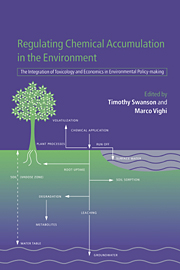 Regulating Chemical Accumulation in the Environment
Regulating Chemical Accumulation in the Environment Published online by Cambridge University Press: 17 August 2009
Introduction
In Italy, atrazine has been used extensively in maize cultivation since the early 1960s. One of the advantages of using atrazine in maize cultivation is flexibility in the timing of the application. Unfortunately, however, its chemical properties make it a likely source of groundwater contamination, especially in areas with permeable soils. In some areas of the Po Valley in northern Italy, where maize cultivation is extensive and groundwater the dominant source of drinking water, chemical monitoring in the 1980s revealed that concentrations of atrazine exceeded 0.1 μg/l i.e. the maximum admissible concentration set by the Directive on Drinking Water Quality of 15 July 1980 (see Vighi and Zanin, 1994, for examples of monitoring results). Following the implementation of local restrictions in 1986, a nationwide ban on the sale and use of atrazine was introduced in 1990.
An earlier pilot study was conducted to address the question of whether the EC standard, with specific reference to atrazine in Italy, could be justified in terms of social efficiency; that is, is 0.1 μg/l a socially efficient contamination level (Bergman and Pugh, 1997)? Broadly speaking, this question can be answered in the affirmative if 0.1 μg/l is the concentration of atrazine in drinking water for which the marginal cost of reducing the concentration is equal to the marginal benefit of a reduced concentration (see Söderqvist et al., 1995, for a basic introduction to these issues). We confine ourselves here to noting that reduction costs may, inter alia, be due to farmers having to turn to more costly weed eradication methods, and that reduced health risks may be one important constituent of reduction benefits.
To save this book to your Kindle, first ensure [email protected] is added to your Approved Personal Document E-mail List under your Personal Document Settings on the Manage Your Content and Devices page of your Amazon account. Then enter the ‘name’ part of your Kindle email address below. Find out more about saving to your Kindle.
Note you can select to save to either the @free.kindle.com or @kindle.com variations. ‘@free.kindle.com’ emails are free but can only be saved to your device when it is connected to wi-fi. ‘@kindle.com’ emails can be delivered even when you are not connected to wi-fi, but note that service fees apply.
Find out more about the Kindle Personal Document Service.
To save content items to your account, please confirm that you agree to abide by our usage policies. If this is the first time you use this feature, you will be asked to authorise Cambridge Core to connect with your account. Find out more about saving content to Dropbox.
To save content items to your account, please confirm that you agree to abide by our usage policies. If this is the first time you use this feature, you will be asked to authorise Cambridge Core to connect with your account. Find out more about saving content to Google Drive.